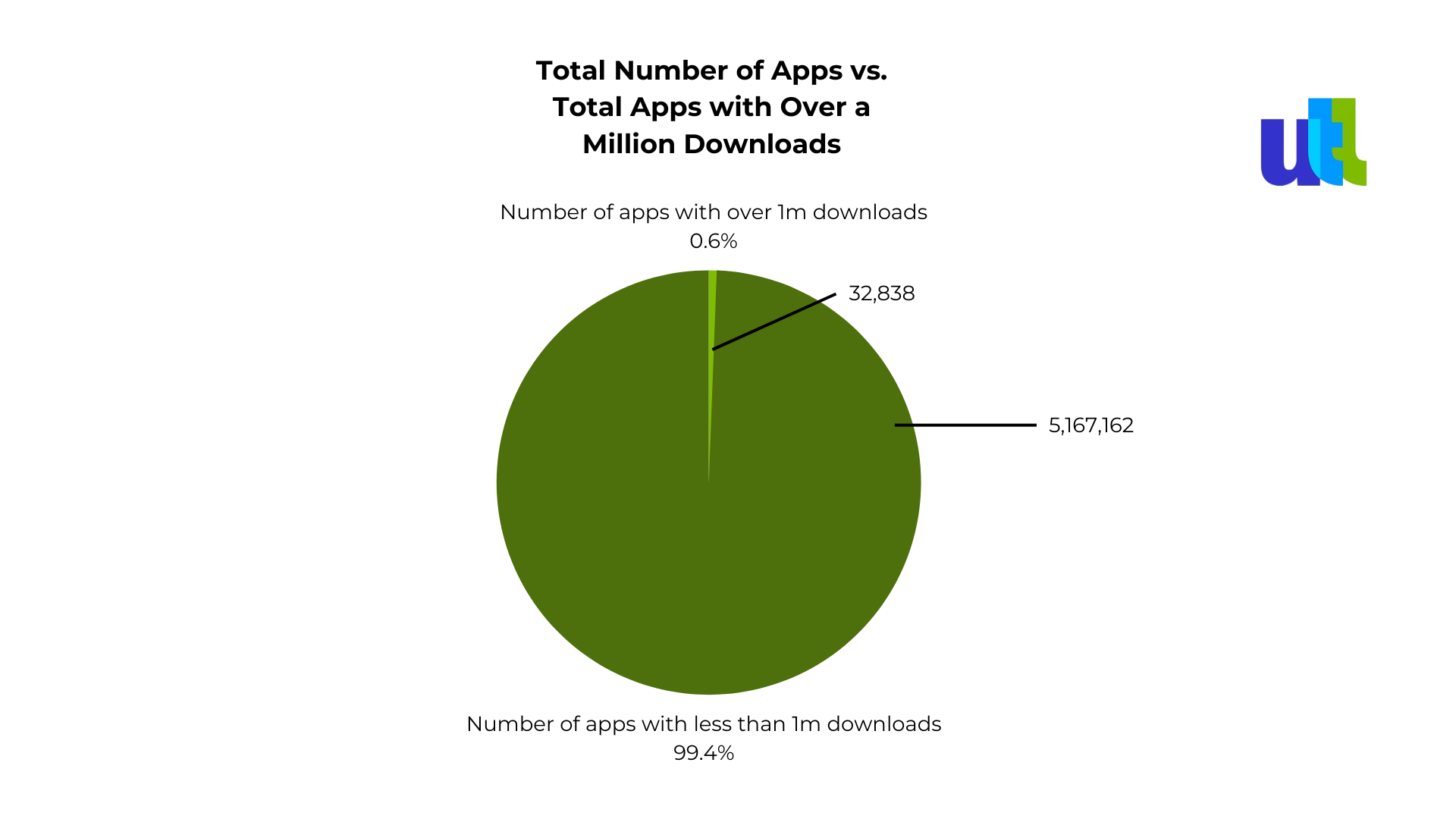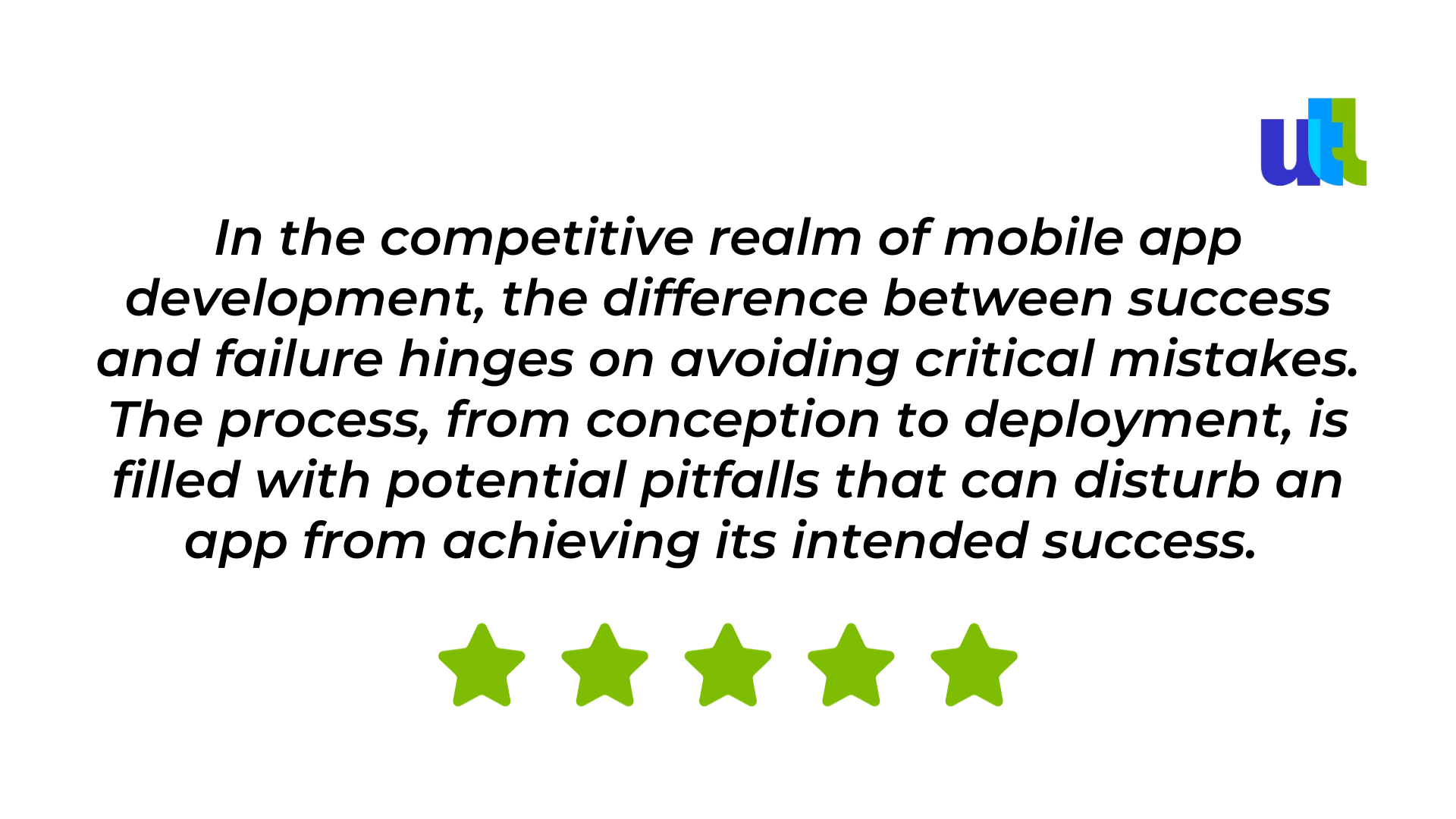In the bustling world of mobile applications, the line between success and failure is often thin. With millions of apps competing for attention, just a small fraction achieves the desired milestone of significant downloads and user engagement.

Why Addressing Common Mistakes is Crucial for Your Mobile App’s Success
This blog post dives deep into the 11 most critical mistakes in mobile app development that could hinder your project from its path to success. These missteps range from fundamental errors such as misjudging your target audience and underestimating development costs, to technical oversights like ignoring platform-specific guidelines or entrusting your project to inexperienced developers. Such mistakes not only diminish the user experience but can also adversely affect the app's performance and reception in the market.
Understanding these common errors is not just about avoiding failure; it's about paving the way for success. Every mobile app out there – even the ones topping the charts today – has faced its fair share of challenges. But it's how these challenges are navigated that separates the winners from the rest.
Your Guide Through the Maze of Mobile App Development
Whether you’re a seasoned developer, a first-time app entrepreneur, or someone trying to salvage an app project that didn’t take off as expected, this blog is for you. It's not merely a list of what not to do; it’s a guide to walk you through the complex way of mobile app development.

Mistake #1: Failing to Comprehend Your Target Audience
One of the most critical yet often overlooked aspects in mobile app development is truly understanding your target audience. This isn't just about having a vague idea of who might use your app; it involves a deep and structured approach towards comprehending the specific needs, behaviors, and preferences of your potential users. It starts with laying the foundation through comprehensive market research. This process should encompass:
- Developing User Personas: Creating detailed profiles for different user categories that might engage with your app.
- Competitive Analysis: Studying existing similar apps to discern what they're doing right or wrong.
- Soliciting Feedback: Engaging in surveys and interviews with your prospective audience to grasp their expectations and needs for your app.
Neglecting this essential phase of development can be compared to embarking on a journey without a certain direction; such an oversight might lead to a destination far removed from the originally intended one.
Consider this: before you even begin to code or design, make sure you're building something that your audience actually wants and needs. Testing the waters with potential users can not only improve customer acquisition but also play a significant role in maintaining user engagement. Skipping this step is a gamble that can cost you in terms of both time and resources. Remember, a successful app is not just about great code or an eye-catching design; it's about how well it fits into the lives of the users it's intended for.
Mistake #2: Poor User Interface Design (UI/UX)
A mobile app's success hinges significantly on its User Interface (UI) and User Experience (UX) design. Both need to be aesthetically appealing and user-centric. Overlooking these can lead to usability challenges and user abandonment. Consistent design, quick loading graphics, and a strategic UI roadmap are essential. While animations can elevate user experience, they should be used occasionally to prevent frustration.
Common risks to avoid include prolonged loading times, cluttered designs, and redundant features. According to MobileAppDaily, poor UI/UX is a primary reason for app uninstalls. Continuous user feedback is vital for refining the design, ensuring it meets user expectations while maintaining technical excellence. Prioritizing user-centric design is the key to balancing aesthetics, functionality, and engagement in an app.
Inadequate User Interface (UI) and User Experience (UX) design significantly hinder a mobile app's potential for success. An app must not only captivate users with an aesthetically pleasing design but also offer an intuitive, user-friendly experience to keep them engaged and satisfied. Neglecting these aspects can lead to significant usability issues, ultimately resulting in user dissatisfaction and app abandonment.
Mistake #3: Ignoring Platform Guidelines
Ignoring the detailed guidelines of mobile platforms like Apple's App Store and Google Play Store can result in severe complications, including your app's direct rejection. It's vital to recognize that following these guidelines goes beyond mere formalities; it's pivotal to app development. Apple's guidelines, covering safety, performance, and design standards, ensure smooth app approvals and bolster user trust. Similarly, Google's policies emphasize content restrictions, privacy, and intellectual property, ensuring your app's integrity and security. Non-compliance can lead to app rejections, incurring additional costs, delays, and impacting the user experience. In essence, careful compliance to platform-specific rules is more than just meeting regulatory standards; it's a strategic move to guarantee both app approval and an flawless user experience.
Mistake #4: Not Optimizing Mobile Apps for Performance
Ensuring top-notch performance is a vital aspect of mobile app development, as it directly impacts user satisfaction and app ratings. Loading speed is a key user expectation, addressed by optimizing images, employing caching strategies, and utilizing content delivery networks (CDNs) to ensure rapid content loading. Additionally, the team understands the importance of battery efficiency; apps that excessively drain battery life are often quickly uninstalled.
This careful attention to performance optimization during the development phase is essential in delivering a seamless, engaging user experience, crucial for maintaining high performance standards on diverse devices and platforms. Ignoring these elements of performance optimization can detrimentally affect the user experience, potentially leading to lower app download rates. Therefore, selecting a development partner like UtahTechLabs, who possesses the expertise to craft a high-performing product, is critical in the competitive landscape of mobile applications.
Mistake #5. Adding Too Many Features
Overloading a mobile app with excessive features can detract from user experience, making the application overwhelming and confusing. Regularly incorporating user feedback during development is critical, as it helps in pinpointing which features are genuinely beneficial or require clarification. This approach leads to a well-optimized product, finely tuned to its users' needs. Excessive features can lead to a bulky, slow, and hard-to-maintain app, negating the value they're supposed to add. Moreover, the development costs, time, and resources associated with adding numerous features should be carefully considered to maintain efficiency and purpose.
While many developers and marketers view having a “feature-rich” app as a positive, user feedback often suggests otherwise. An app crowded with too many features can become inconvenient, contributing little to enhancing the overall user experience. Instead, a focused, feature-limited app tends to be more purposeful and easier to navigate.
Remember, simplicity can often equate to sophistication in mobile app development. A cluttered, feature-heavy app not only provides a disorienting experience but can also be challenging to market. Many apps fail at launch because they attempt to incorporate too many features. A successful mobile app should ideally have a straightforward, easy-to-understand feature set that appeals to and retains users.
Mistake #6: Underestimating the Costs
A common mistake in mobile app development is underestimating the costs associated with the entire development process. Such miscalculations can lead to budgetary constraints, potentially resulting in a half-done product. It's imperative to get a comprehensive understanding of the associated expenses to create a top-notch app.
To get a realistic cost estimate, researching the industry's average app development prices is a good starting point. Factors to consider include design, development, testing, maintenance, and marketing. Cutting corners on pivotal features or services in a bid to save money might jeopardize the app's quality and user experience.
Furthermore, app development is not just a significant monetary investment. It also involves considerations like development hours, resources, overheads, and potentially a specialized team for marketing or operations. These elements should be carefully evaluated before the project's onset to prevent unwelcome surprises.
Lastly, effective budget management is critical, regardless of your project's scale. Establishing a detailed budget, accounting for unexpected costs, and adhering to this budget can make the difference between a successful app and a costly misstep. In essence, while app development is intricate and tailored to individual needs, financial planning ensures the project starts on the right foot.
Mistake #7: Overlooking the Importance of an MVP
An MVP, or Minimum Viable Product, serves as a crucial safety net, preventing potential missteps in app development. It provides real-world users an opportunity to evaluate your app's core features and effectiveness, thereby obtaining genuine feedback in actual market scenarios before the app's final version is introduced. Adopting this strategy accelerates the enhancement journey, leading to a quicker product launch. Giants like Uber and Instagram have leveraged the MVP approach to unveil immensely popular apps.
Mistake #8: Not Communicating Enough with Developers
Effective dialogue is the cornerstone of any prosperous app development attempt. Fully conveying your app vision to the development team can be challenging, but it's crucial. The clarity of your instructions can significantly influence the project's outcome. To ensure your vision translates accurately, provide comprehensive specifications without leaving room for guesswork. When outlining your app's requirements, include a clear summary, visual blueprints, and an exhaustive list of functionalities.
Typically, seasoned developers will need this information to move forward. Once presented, anticipate feedback and an estimated project cost. This initial interaction offers a glimpse into the developers' communication style, allowing you to assess compatibility. While there's no universal blueprint for this phase, proactive research and preparation can mitigate potential problems down the line.
Mistake #9: Replicating Your Website or Desktop App
If you've previously developed a web or desktop application, it's natural to feel attached to its design and functionality. However, directly duplicating its features and layout onto a mobile app isn't recommended. Mobile and desktop platforms serve different user experiences. Rather than viewing the mobile app as a scaled-down version of your desktop platform, it's crucial to design it with mobile-specific functionalities in mind. Although maintaining a consistent branding theme, such as color schemes, is beneficial, the primary focus should be on optimizing the user experience tailored to mobile usage. Mobile apps, especially native ones, should be designed to maximize performance, leveraging the unique aspects of mobile devices. The design and features should be reflective of how consumers interact with mobile devices, distinct from desktop interactions.
Mistake #10. Developing an App for Too Many Platforms at Once
Diving headfirst into developing an app for numerous platforms simultaneously can be a risky move, especially for newcomers. While established brands might offer apps across multiple devices, it's not always wise for budding developers to emulate this. Expanding to various platforms at once can drain financial resources; for instance, crafting both iOS and Android apps at the same time effectively doubles the investment. This isn't economical for a young app.
Each platform demands its own unique user experience nuances. A smarter approach is to launch on one platform, gather user feedback, make necessary adjustments, and then consider branching out. Spreading too thin from the get-go mirrors the pitfalls of overloading an app with features—it can strain your budget and weaken your initial vision. Before hopping on to multi-platform development, start with comprehensive market research, launch on a single chosen platform like Android, iOS, or Windows, and ensure its success there. If you're set on a multi-platform launch, thorough pre-planning is essential.
Mistake #11: Falling into the Endless Perfection Cycle
While many developers prioritize app downloads as the indication of success, it's essential to understand that downloads are just the starting point. Merely having high download figures doesn't guarantee the app's sustained success. Many companies invest heavily in attracting new users, but equal importance should be given to keeping those users engaged.
Engaged users not only provide a solid foundation for a significant return on investment but also become ambassadors for the brand through word-of-mouth marketing and valuable feedback. To foster user engagement and retention, it's vital to ensure a seamless onboarding process, utilize push notifications effectively, send personalized in-app messages, entice users with special offers and rewards, and continually seek and act upon user feedback. In essence, a truly prosperous app strikes a balance between attracting new users and retaining them over time.
Conclusion

If you're on the lookout for skilled and seasoned app developers to bring your digital ideas to life, consider reaching out to UtahTechLabs. Known for the expertise and innovative approach, UtahTechLabs boasts a team of professional developers who specialize in creating custom, user-friendly, and efficient applications tailored to your specific needs. Whether it's for iOS, Android, or cross-platform solutions, we leverage the latest technologies and industry best practices to ensure your project's success. Dedicated to delivering exceptional results and fostering long-term partnerships, UtahTechLabs is your go-to choice for transforming your vision into a functional and engaging app.
For free consultation on mobile app development mistakes, click here.
----------------------------------------------------------------------------------------------
View the full presentation:
WRITTEN BY
Milda Butkeviciute
2023-11-06


































































































































































































